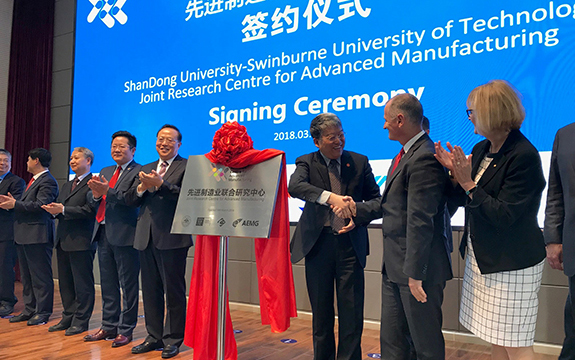Swinburne launches advanced manufacturing centre in Weihai, Shandong

In Summary
- First Australian university to establish base in Weihai, Shandong
- Connecting with industry in China, South Korea
- Initial focus on 3D printing, advanced manufacturing and materials, robotics
A new research centre has been launched in Weihai, Shandong, connecting Swinburne with industry in China and South Korea.
The is a partnership between Swinburne, Shandong University Weihai (SDUW), Weihai Economic and Technological Development Zone (WZ) and the Australian Education and Management Group (AEMG).
The centre will develop advanced manufacturing technologies, including:
- 3D printing
- Industrial automation and robotics
- Advanced materials processing for carbon fibre composites
- Digitalisation across the value chain from design to business supply chain innovation.
In the first five years, the centre will house 100 PhD research students working on high impact projects supported by industry from Australia, US and South Korea.
Supporting Australia-China trade
Swinburne is the first Australian university to develop a base in Weihai, an area experiencing economic growth based on industries including automobiles, machinery, pharmaceuticals, and food processing.
Speaking at the launch, Swinburne President and Vice-Chancellor Professor Linda Kristjanson, AO, said the initiative will become a whole-of-university partnership.
“Swinburne intends to broaden and deepen engagement with Shandong University and with industry in the economic and technological development zone across all domains of our endeavour,” she says.
“Our vision is that the relationships we build through our initiative here in Weihai will advance and support trade between our nations across a range of sectors.”
Unique partnership between universities and industry
The launch was attended by representatives of the Australian and Victorian governments and by the City of Weihai.
Deputy Vice-Chancellor (Research and Development) Professor Aleksandar Subic says Swinburne has also entered formal collaborations with six industry partners in Shandong.
“Our partnership model is unique as it goes beyond academic collaboration and involves industry and the economic and technological development zone,” he says.
Swinburne and CSIRO connect Australia, China and Silicon Valley
Swinburne partner, the CSIRO, joined the event following the launch of the Swinburne-CSIRO joint presence in Silicon Valley, California in January.
Swinburne is also the only university to join the CSIRO and representatives of the Australian manufacturing sector on the Prime Minister’s Industry 4.0 Taskforce.
“Swinburne and the CSIRO aim to collaborate on industry projects of joint interest in China as part of our strategic research alliance,” says Professor Subic.
“We live in exciting times of fundamental technological and industrial transformation. The pace and scope of ground-breaking scientific and technological advances resulting from research and innovation is unprecedented.
“We anticipate that in the coming decades, the technologies driving the fourth industrial revolution will fundamentally transform the entire structure of the world economy, how we work, create and trade.
“We have a responsibility to establish deeper and more trusting relationships in the region now in order for our industries and communities to benefit in the future.”
 Victoria’s Commissioner to China, Tim Dillon joined Vice-Chancellor Professor Linda Kristjanson, AO and Australia’s Senior Trade Commissioner for North China, Dan Tebbutt on a tour of Swinburne facilities in Weihai.
Victoria’s Commissioner to China, Tim Dillon joined Vice-Chancellor Professor Linda Kristjanson, AO and Australia’s Senior Trade Commissioner for North China, Dan Tebbutt on a tour of Swinburne facilities in Weihai.

